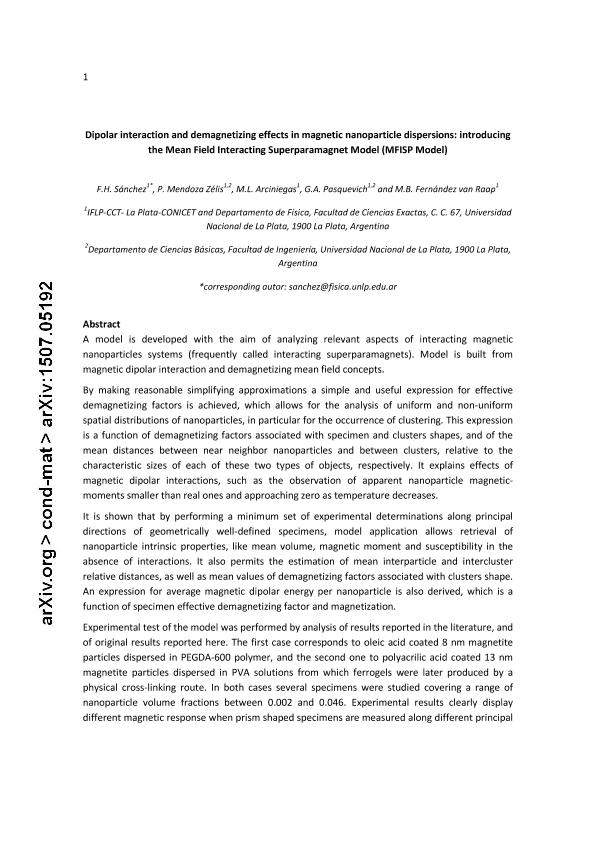Mostrar el registro sencillo del ítem
dc.contributor.author
Sánchez, Francisco Homero

dc.contributor.author
Mendoza Zélis, Pedro

dc.contributor.author
Arciniegas Vaca, Magda Lorena

dc.contributor.author
Pasquevich, Gustavo Alberto

dc.contributor.author
Fernández van Raap, Marcela Beatriz

dc.date.available
2018-11-08T18:15:15Z
dc.date.issued
2017-04
dc.identifier.citation
Sánchez, Francisco Homero; Mendoza Zélis, Pedro; Arciniegas Vaca, Magda Lorena; Pasquevich, Gustavo Alberto; Fernández van Raap, Marcela Beatriz; Dipolar interaction and demagnetizing effects in magnetic nanoparticle dispersions: Introducing the mean-field interacting superparamagnet model; American Physical Society; Physical Review B; 95; 13; 4-2017; 1-18; 134421
dc.identifier.issn
2469-9969
dc.identifier.uri
http://hdl.handle.net/11336/63997
dc.description.abstract
Aiming to analyze relevant aspects of interacting magnetic nanoparticle systems (frequently called interacting superparamagnets), a model is built from magnetic dipolar interaction and demagnetizing mean-field concepts. By making reasonable simplifying approximations, a simple and useful expression for effective demagnetizing factors is achieved, which allows the analysis of uniform and nonuniform spatial distributions of nanoparticles, in particular the occurrence of clustering. This expression is a function of demagnetizing factors associated with specimen shape and clusters shape, and of the mean distances between near neighbor nanoparticles and between clusters, relative to the characteristic sizes of each of these two types of objects, respectively. The model explains effects of magnetic dipolar interactions, such as the observation of apparent nanoparticle magnetic moments smaller than real ones and approaching to zero as temperature decreases. It is shown that by performing a minimum set of experimental determinations along principal directions of geometrically well-defined specimens, model application allows retrieval of nanoparticle intrinsic properties, like mean volume, magnetic moment, and susceptibility in the absence of interactions. It also permits the estimation of mean interparticle and intercluster relative distances, as well as mean values of demagnetizing factors associated with clusters shape. An expression for average magnetic dipolar energy per nanoparticle is also derived, which is a function of specimen effective demagnetizing factor and magnetization. Experimental test of the model was performed by analysis of results reported in the literature and of original results reported here. The first case corresponds to oleic-acid-coated 8-nm magnetite particles dispersed in PEGDA-600 polymer, and the second one to polyacrilic-acid-coated 13-nm magnetite particles dispersed in PVA solutions from which ferrogels were later produced by a physical cross-linking route. In both cases, several specimens were studied covering a range of nanoparticle volume fractions between 0.002 and 0.046. Magnetic response is clearly different when prism-shaped specimens are measured along different principal directions. These results remark the importance of reporting complete information on measurement geometry when communicating magnetic measurement results of interacting magnetic nanoparticles. Intrinsic nanoparticle properties as well as structural information on particles spatial distribution were retrieved from our analysis in addition to, and in excellent agreement with, analysis previously performed by other authors and/or information obtained from FESEM images. In the studied samples, nanoparticles were found to be in close contact to each other within almost randomly oriented clusters. Intercluster mean distance, relative to cluster size, was found to vary between 2.2 and 7.5, depending on particles volume fraction.
dc.format
application/pdf
dc.language.iso
eng
dc.publisher
American Physical Society

dc.rights
info:eu-repo/semantics/openAccess
dc.rights.uri
https://creativecommons.org/licenses/by-nc-sa/2.5/ar/
dc.subject
Magnetic Nanoparticles
dc.subject
Dipolar Interaction
dc.subject
Interacting Superparamagnet Model
dc.subject
Hidrogel
dc.subject.classification
Otras Ciencias Físicas

dc.subject.classification
Ciencias Físicas

dc.subject.classification
CIENCIAS NATURALES Y EXACTAS

dc.title
Dipolar interaction and demagnetizing effects in magnetic nanoparticle dispersions: Introducing the mean-field interacting superparamagnet model
dc.type
info:eu-repo/semantics/article
dc.type
info:ar-repo/semantics/artículo
dc.type
info:eu-repo/semantics/publishedVersion
dc.date.updated
2018-10-22T21:54:30Z
dc.journal.volume
95
dc.journal.number
13
dc.journal.pagination
1-18; 134421
dc.journal.pais
Estados Unidos

dc.description.fil
Fil: Sánchez, Francisco Homero. Consejo Nacional de Investigaciones Científicas y Técnicas. Centro Científico Tecnológico Conicet - La Plata. Instituto de Física La Plata. Universidad Nacional de La Plata. Facultad de Ciencias Exactas. Instituto de Física La Plata; Argentina
dc.description.fil
Fil: Mendoza Zélis, Pedro. Consejo Nacional de Investigaciones Científicas y Técnicas. Centro Científico Tecnológico Conicet - La Plata. Instituto de Física La Plata. Universidad Nacional de La Plata. Facultad de Ciencias Exactas. Instituto de Física La Plata; Argentina
dc.description.fil
Fil: Arciniegas Vaca, Magda Lorena. Consejo Nacional de Investigaciones Científicas y Técnicas. Centro Científico Tecnológico Conicet - La Plata. Instituto de Física La Plata. Universidad Nacional de La Plata. Facultad de Ciencias Exactas. Instituto de Física La Plata; Argentina
dc.description.fil
Fil: Pasquevich, Gustavo Alberto. Consejo Nacional de Investigaciones Científicas y Técnicas. Centro Científico Tecnológico Conicet - La Plata. Instituto de Física La Plata. Universidad Nacional de La Plata. Facultad de Ciencias Exactas. Instituto de Física La Plata; Argentina
dc.description.fil
Fil: Fernández van Raap, Marcela Beatriz. Consejo Nacional de Investigaciones Científicas y Técnicas. Centro Científico Tecnológico Conicet - La Plata. Instituto de Física La Plata. Universidad Nacional de La Plata. Facultad de Ciencias Exactas. Instituto de Física La Plata; Argentina
dc.journal.title
Physical Review B
dc.relation.alternativeid
info:eu-repo/semantics/altIdentifier/url/http://link.aps.org/doi/10.1103/PhysRevB.95.134421
dc.relation.alternativeid
info:eu-repo/semantics/altIdentifier/doi/http://dx.doi.org/10.1103/PhysRevB.95.134421
dc.relation.alternativeid
info:eu-repo/semantics/altIdentifier/url/https://arxiv.org/abs/1507.05192
Archivos asociados
